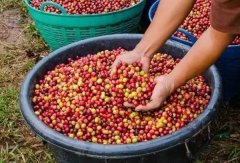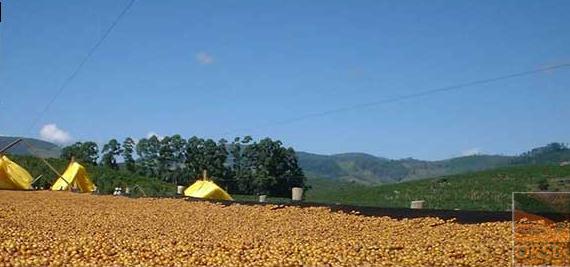The reason for the charming flavor of Yega Xuefei: unique coffee planting pattern and Ethiopian native species

Professional barista communication, please pay attention to coffee workshop (Weixin Official Accounts cafe_style)
Coffee cultivation in Ethiopia is divided into:
Forest coffee forest coffee (8-10%), coffee trees and other crops coexist in the original forest, without any artificial care, farmers will regularly pick coffee fruit.
● Forest-semiforest coffee (30-35%), coffee tree planting area is located around the forest and farmers 'living area, coffee tree and forest coffee are the same natural production varieties, farmers will manage coffee tree planting area and plant other cash crops.
● Garden coffee (50-55%), coffee trees are planted around farmers 'living areas, and most of them are coffee planted by farmers themselves.
Plantation coffee (5-6%), large private growers with more processing facilities and production capacity.
Most coffee cultivation in Sidamo and Yegashefi is based on the pastoral coffee model, in which coffee farmers grow their own coffee trees near their living areas and harvest them during harvest season, then send them to nearby water-dependent processing plants for centralized processing (or centralized acquisition by middlemen). Except for a small number of plantation estates that have the strength to plant, pick and process coffee beans independently, coffee beans from many different regions and varieties will be processed centrally by the processing plant and then sent to the auction house for official evaluation and grading. This is why many Ethiopian coffee beans are named after the processing plant or cooperative, and it is also one of the reasons why the same batch of coffee beans is mixed with multiple coffee varieties, and even the flavor of different batches of coffee beans produced by the same processing plant can be significantly different.
There are eight main coffee producing areas in Ethiopia: Nekempte (Lekempti) Gimbi Kimbi, Limu Limu, Illubabor Ibedo, Djimma, Harrar Hara, Teppi/Bebeka, Sidamo Sidamo, Yirgacheffe Yigacheffe, among which the more famous boutique coffee producing areas
Nekempte (Lekempti), Limu, Harrar, Sidamo, Yirgacheffe, Yirgacheffe is located in Sidama administrative region of Ethiopia, Africa, and Yirgacheffe belongs to a smaller area within Sidama.
Yerga Sherphine itself is a small town with a population of about 20,000. The three neighboring small producing areas Wenago, Kochere and Gelena Abaya are also classified as Yerga Sherphine because the flavor of coffee produced is almost identical to Yerga Sherphine. Yerga Coffee is culturally and geographically similar to its neighbors, but Yerga Coffee seems to be blessed with exceptional conditions. Top quality Yerga Coffee has floral, bright citrus fruit, lemon notes and silky soft taste.
Kochere Kochere is located in south-west Ethiopia, about 25 miles north of the famous town of Yegasherfi, and its production model is based on local smallholders sending batches of output to cooperatives for centralized processing. The local Chalalacktu village has about 100,000 people who depend on coffee for their livelihood, and related production activities have become their main source of income. Due to the benefits brought by coffee production, the local living standard is much better than that of many Ethiopian villages, and there are complete health facilities, higher schools, etc. Advanced processing equipment allows Kochere coffee to consistently perform at a high level in washed areas, with molasses and citrus complex tones clean and sweet.
Ethiopia is a country full of magic. What we call Arabica coffee originated here.
There are nearly 2000 coffee varieties recorded in Ethiopia, including 1927 native varieties and 128 introduced varieties. Therefore, if you look at the face value, Ethiopia's coffee variety is "Grand View Garden", which has everything, long, short, thin, fat...
Long particles are found in coffee growing areas all over Ethiopia. From the actual proportion, Jimma in the west, including Limmu and Kaffa, will have more long particle varieties, and Sidama or yirgacheffe will have less proportion.
Small particle species, round in shape, small in size, mostly between 14-15 mesh, this variety should be the most familiar to us, they can often be seen in Sidama and Yejia Shefei, I have also seen in a harrar sample, also seen in Jimma local coffee beans sold, compared to other areas, Sidama and yigracheffe and surrounding arsi, guji have more of this small particle of the original variety planted.
In addition to the variety of coffee, coffee cultivation methods also affect the variety of Ethiopian coffee beans.
Country: Ethiopia Fiscal year: 2003
Grade: G1
Production area: Yejia Xuefei
Degree of baking: Light baking
Treatment method: washing
Breed: Native species
Flavor: Jasmine, lemon, bergamot, honey, black tea
Kocher is located in a small producing area 25 kilometers southeast of Yejia Shefi in Ethiopia. It is a rich coffee producing area and one of the three famous micro-producing areas in Yejia Shefi. The local population is about 100,000. Coffee beans are the main source of income. The processing equipment of this producing area is very advanced. Coffee Review rated Kocher's beans 94 points.
Important Notice :
前街咖啡 FrontStreet Coffee has moved to new addredd:
FrontStreet Coffee Address: 315,Donghua East Road,GuangZhou
Tel:020 38364473
- Prev

Ethiopia's pride-Yegashefi coffee has a wide variety, rich flavor and charming aroma.
Professional barista communication please pay attention to the coffee workshop (Wechat official account cafe_style) Ethiopia is a country full of wonders, and what we are talking about here is the origin of all the Arabica coffee we have never had before. Nearly 2000 coffee varieties have been recorded in Ethiopia, including 1927 native varieties and 128 imported varieties. So just look.
- Next

Brazil COE third Runner-up Shenmu Manor Sun Yellow bourbon Variety introduction to Shenmu Manor
Brazil COE third runner-up Shenmu Manor, yellow bourbon variety, sun [flavor] in the medium and deep baked taste, clean and balanced walnut taste, creamy and smooth texture coupled with sweet orange sweetness, full of mocha chocolate finish. About Shenmu Manor Shenmu Manor is located in the southern mountains of Minas Gerais, about 1200 meters above sea level.
Related
- Does Rose Summer choose Blue, Green or Red? Detailed explanation of Rose Summer Coffee plots and Classification in Panamanian Jade Manor
- What is the difference between the origin, producing area, processing plant, cooperative and manor of coffee beans?
- How fine does the espresso powder fit? how to grind the espresso?
- Sca coffee roasting degree color card coffee roasting degree 8 roasting color values what do you mean?
- The practice of lattes: how to make lattes at home
- Introduction to Indonesian Fine Coffee beans-- Java Coffee producing area of Indonesian Arabica Coffee
- How much will the flavor of light and medium roasted rose summer be expressed? What baking level is rose summer suitable for?
- Introduction to the characteristics of washing, sun-drying or wet-planing coffee commonly used in Mantenin, Indonesia
- Price characteristics of Arabica Coffee Bean Starbucks introduction to Manning Coffee Bean Taste producing area Variety Manor
- What is the authentic Yega flavor? What are the flavor characteristics of the really excellent Yejasuffi coffee beans?

